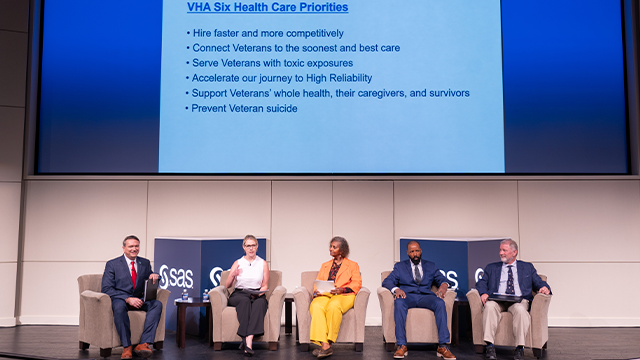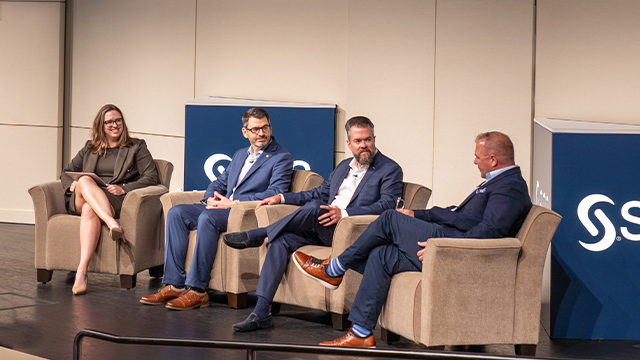SAS takes its pledge to support US veterans and military families to heart. So, when the 2022 the PACT Act expanded Veterans Affairs (VA) health care and benefits for those exposed to toxic substances, a collective team at SAS pulled together to help inform the community.
Expanding Care for Our Veterans: VA Health Care and Benefits for Veterans Exposed to Toxic Substances was held on June 27, at SAS world headquarters for that very reason.
“Veterans represent the best of us, and we are committed to doing everything we can to better represent veterans within our workforce and drive better outcomes for you,” said Paula Henderson, EVP, Americas Sales, in her opening remarks. “We also want to do our part in supporting the rollout of the PACT Act, and we appreciate you being here with us to host this very important conversation.”
6 things you can do to help build awareness of the PACT Act
- Visit the PACT Act site to get all the facts.
- Talk with friends and family who are veterans or survivors who may not be aware of the act.
- Encourage veterans to get screened at a VA location. VA medical teams are more likely to understand and associate certain symptoms with military service.
- Encourage eligible veterans to apply for VA health care now, even if they don’t currently need benefits. They might need benefits, including assisted living and services for the aging, later in life.
- Remind veterans and survivors to act before Aug. 9, 2023, to be considered for benefits backdated to Aug. 10, 2022.
- If you’re tech savvy, help a veteran who isn’t as comfortable to apply online. You can also connect them to an accredited representative who can help by calling 1-800-MyVA411 (1-800-698-2411).
Henderson noted that SAS and the VA have been working together to improve outcomes since 1993. More than 3,000 VA data professionals currently use our software, and an additional 35,000 VA academic affiliated researchers also use SAS to advance VA research.
Leaders from state and local veteran agencies along with others in the community came together to learn about the new law that is expected to bring an additional 3.5 million veterans into VA care.
A concerted effort
The massive, comprehensive aspects of the PACT Act will require an emphasis on modernization, development and expansion of information technology systems at the VA. It will also require expanding claims processing for newly eligible veterans – something keynote speaker Steve Miska, Executive Director of the PACT Act for the US Department of Veterans Affairs, knows a little something about.

VA began working on new cases on Jan. 1, and they’re now processing about half of the 650,000 cases that have been submitted since that time. It is not unusual for his team to process more than 8,000 cases each workday.
“We’re fighting like hell to get these benefits out there,” Miska said.
For Vietnam veterans and survivors, that includes claims for two Agent Orange conditions. For the Gulf War and post 9-11 veterans and survivors, that includes numerous types of cancer, asthma, and 300 other chronic conditions.
What they’re fighting now: Time and myths
There’s no deadline to apply for PACT Act benefits. But if veterans or survivors file their PACT Act claim – or just submit their intent to file – by Aug. 9 of this year, they may receive benefits backdated to Aug. 10, 2022, the day the bill was signed into law. So, acting quickly is critical.
But in addition to fighting time, Miska said they’re also fighting several circulating myths:
Myth 1: Some veterans are concerned that filing for new benefits could put their existing benefits at risk.Data shows that claimants are 32 times more likely to stay at the same level of benefit or increase their benefit.
Myth 2: Some veterans have heard they will need to pay to apply for claims. There are no fees to apply, and the VA will never charge veterans for processing a claim. Be wary of scams designed to perpetuate this belief.
Myth 3: Some survivors believe benefits are only for veterans. The PACT Act makes receiving dependency and indemnity compensation easier for survivors, and other allowances, payments and benefits are available to them.
Myth 4: Some believe the VA won’t be able to handle the influx, so it’s not worth filing. The VA is processing and delivering benefits more quickly and to more veterans than at any time in the nation’s history.
Myth 5: You can only apply online and it’s complicated. The heightened level of enrollments and cases does require systems development and modernization – not to mention that the average enrolled age group is Gen X. But VA-accredited representatives and veteran service officers are always available to help in person, via phone, or snail mail.
“My ask: Reach out to veterans in your family or veterans who may not have had a positive experience with the VA in the past,” Miska said. “We are not your father or mother’s generation of the VA. We are actively trying to reach out and engage with our country’s veterans, let them know about the benefits they have earned and deserve because of their service.”
VA is working hard to meet demand, hiring 50,000 new employees in anticipation of the veterans that will sign up for PACT. “Only half of the 18 million veterans in the US are in the VA system,” he said. “But PACT opens the aperture for millions.”
Two expert panels followed the keynote presentation. One was led by SAS Medical Director Steve Kearney, who was joined by VA officials to talk about supporting PACT Act efforts at the local level. SAS Director of US Government Federal Division Caroline Baldwin moderated another on ways the private sector can support the VA. Both discussions provided event participants with plenty of new insights and actionable ideas they were able to talk about during the networking hour that followed the program.
Closing remarks were offered by US Senator Ted Budd, who praised the work of attendees and pledged his continued support of the US Armed Forces, veterans and their families.




